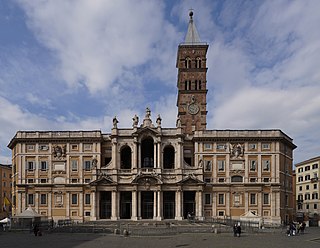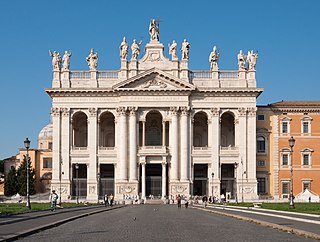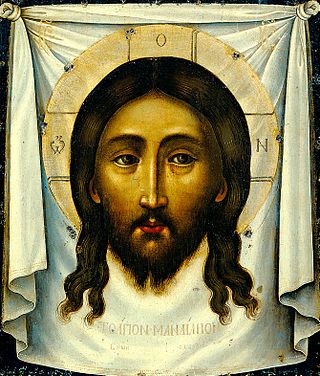
Saint Lawrence or Laurence was one of the seven deacons of the city of Rome under Pope Sixtus II who were martyred in the persecution of the Christians that the Roman Emperor Valerian ordered in 258.

The Archbasilica Cathedral of the Most Holy Savior and of Saints John the Baptist and the Evangelist in the Lateran is the Catholic cathedral church of the Diocese of Rome in the city of Rome, and serves as the seat of the bishop of Rome, the pope. The archbasilica lies outside of Vatican City proper, which is located approximately 4 kilometres (2.5 mi) to the northwest. Nevertheless, as properties of the Holy See, the archbasilica and its adjoining edifices enjoy an extraterritorial status from Italy, pursuant to the terms of the Lateran Treaty of 1929. Dedicated to the Christ, in honor of John the Baptist and John the Evangelist, the place name, Laterano (Lateran) comes from an ancient Roman family (gens), whose palace (domus) grounds occupied the site; the adjacent Lateran Palace was the primary residence of the pope until the Middle Ages.

The Apostolic Palace is the official residence of the Pope, the head of the Catholic Church, located in Vatican City. It is also known as the Papal Palace, the Palace of the Vatican and the Vatican Palace. The Vatican itself refers to the building as the Palace of Sixtus V, in honor of Pope Sixtus V, who built most of the present form of the palace.
A number of alleged relics associated with Jesus have been displayed throughout the history of Christianity. While some individuals believe in the authenticity of Jesus relics, others doubt their validity. For instance, the sixteenth-century philosopher Erasmus wrote about the proliferation of relics, and the number of buildings that could be constructed from wooden relics claimed to be from the crucifixion cross of Jesus. Similarly, at least thirty Holy Nails were venerated as relics across Europe in the early 20th century. Part of the relics are included in the so-called Arma Christi, or the Instruments of the Passion.

The Basilica of Saint Mary Major, or church of Santa Maria Maggiore, is a Major papal basilica as well as one of the Seven Pilgrim Churches of Rome and the largest Catholic Marian church in Rome, Italy.

Sebastiano Conca was an Italian painter.

Lateran and Laterano are the shared names of several buildings in Rome. The properties were once owned by the Lateranus family of the Roman Empire. The Laterani lost their properties to Emperor Constantine who gave them to the Catholic Church in 311.

The Lateran Palace, formally the Apostolic Palace of the Lateran, is an ancient palace of the Roman Empire and later the main papal residence in southeast Rome.

Domenico Fontana was an Italian architect of the late Renaissance, born in today's Ticino. He worked primarily in Italy, at Rome and Naples.

The Basilica of Saint Mary of the Altar in Heaven is a titular basilica in Rome, located on the highest summit of the Campidoglio. It is still the designated church of the city council of Rome, which uses the ancient title of Senatus Populusque Romanus. The present cardinal priest of the Titulus Sanctae Mariae de Aracoeli is Salvatore De Giorgi.

Santa Pudenziana is a church of Rome, a basilica built in the 4th century and dedicated to Saint Pudentiana, sister of Praxedes and daughter of Pudens. It is one of the national churches in Rome, associated with Filipinos.

The Basilica of the Holy Cross in Jerusalem or Basilica di Santa Croce in Gerusalemme is a Catholic Minor basilica and titular church in rione Esquilino, Rome, Italy. It is one of the Seven Pilgrim Churches of Rome.

The Scala Sancta are a set of 28 white marble steps located in an edifice on extraterritorial property of the Holy See in Rome, Italy proximate to the Archbasilica of Saint John in Laterano. Officially, the edifice is titled the Pontifical Sanctuary of the Holy Stairs, and incorporates part of the old Papal Lateran Palace. Replica stairs flank the original staircase, which may only be climbed on one's knees. The Holy Stairs lead to the Church of Saint Lawrence in Palatio ad Sancta Sanctorum or simply the "Sancta Sanctorum", which was the personal chapel of the early Popes.

Acheiropoieta — also called icons made without hands — are Christian icons which are said to have come into existence miraculously; not created by a human. Invariably these are images of Jesus or the Virgin Mary. The most notable examples that are credited by tradition among the faithful are, in the Eastern church, the Mandylion, also known as the Image of Edessa, and the Hodegetria, and several Russian icons, and in the West the Shroud of Turin, Veil of Veronica, Our Lady of Guadalupe, and the Manoppello Image. The term is also used of icons that are only regarded as normal human copies of a miraculously created original archetype.

Cesare Nebbia (c.1536–c.1614) was an Italian Mannerist painter from Orvieto.
This is an index of Vatican City–related topics.

The Abbey of Santa Giustina is a 10th-century Benedictine abbey complex located in front of the Prato della Valle in central Padua, region of Veneto, Italy. Adjacent to the former monastery is the basilica church of Santa Giustina, initially built in the 6th century, but whose present form derives from a 17th-century reconstruction.

Santa Maria della Sapienza is a Roman Catholic church, located on Via Costantinopoli in central Naples, Italy.

The Azienda Ospedaliera San Giovanni Addolorata in Rome (Italy) is one of the largest hospitals in central Italy; the current administrative designation refers to one of the largest and oldest hospitals in the city, commonly designated as San Giovanni hospital.
Giovanni Marangoni (1673–1753) was a Roman Catholic priest and antiquarian.


















